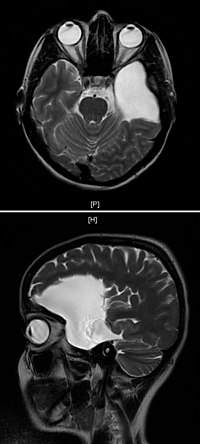
Photo from wikipedia
Background: Arachnoid cysts (AC) may cause hydrocephalus and neurological symptoms, necessitating surgical intervention. Cyst drainage may result in postoperative complications, however, these interventions are not normally associated with the subsequent… Click to show full abstract
Background: Arachnoid cysts (AC) may cause hydrocephalus and neurological symptoms, necessitating surgical intervention. Cyst drainage may result in postoperative complications, however, these interventions are not normally associated with the subsequent development of acute hydrocephalus. Herein, we present two unique cases of AC drainage with postoperative development of acute communicating hydrocephalus. Case Description: Case 1. A 75-year-old female presented with progressive headaches, cognitive decline, and questionable seizures. Her neurological examination was non-focal, but a head computed tomography scan (CT) identified a large right frontal AC with mass effect. She subsequently underwent craniotomy and decompression of the cyst. Postoperatively, her neurological examination deteriorated, and a head CT demonstrated new communicating hydrocephalus. The opening pressure was elevated upon placement of an external ventricular drain. Her hydrocephalus improved on follow-up imaging, but her neurological examination failed to improve, and she ultimately expired. Case 2. A 61-year-old female presented with headache and seizures attributed to a left parietal AC. She underwent open craniotomy for fenestration of the cyst into the Sylvian fissure. Postoperatively, her neurologic examination deteriorated, and she developed acute communicating hydrocephalus. She was initially managed with external ventricular drainage (EVD). The hydrocephalus resolved after several days, and the EVD was subsequently removed. Late follow-up imaging at 2 years showed that the regression of the AC was maintained. Conclusion: Acute development of hydrocephalus is a potential complication of intracranial AC fenestration. A better understanding of intracranial cerebrospinal fluid flow dynamics may better inform as to the underlying cause of this complication.
Journal Title: Surgical Neurology International
Year Published: 2021
Link to full text (if available)
Share on Social Media: Sign Up to like & get
recommendations!